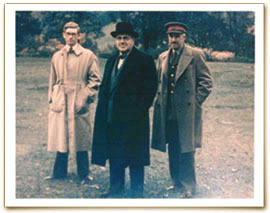Edward Travis

Sir Edward Wilfred Harry Travis KCMG CBE (24 September 1888 – 23 April 1956) was a British cryptographer and intelligence officer, becoming the operational head of Bletchley Park during World War II, and later the head of GCHQ.
Career
[edit]Educated locally in Blackheath, Travis joined the Royal Navy in 1906 as a Paymaster officer, and served on HMS Iron Duke.[1] From 1916 to 1918, he worked on Navy cyphers. He retired in 1921, having reached the rank of Paymaster Lieutenant-Commander,[2] and was advanced to Paymaster Commander in 1927.[3]
By 1925, he was in charge of security at the Government Code and Cypher School (GC&CS) and deputy to Alastair Denniston.[1] Travis replaced Denniston as the operational head of Bletchley Park in February 1942, although both took the title of Deputy Director.[1] This may have happened because in October 1941 four senior cryptanalysts, Alan Turing, Gordon Welchman, Conel Hugh O'Donel Alexander, and Stuart Milner-Barry had written directly to Churchill, over the head of Denniston, to alert Churchill to the fact that a shortage of staff at Bletchley Park was preventing them from deciphering many messages, to the detriment of the war effort. These cryptanalysts, known as the Wicked Uncles, had also praised the "energy and foresight" of Commander Travis while omitting mention of Denniston.[4] However, Christopher Grey notes that other factors also contributed to Travis' promotion, including a personality clash between Denniston and Stewart Menzies, the Director of the Government Code and Cypher School and the head of the Secret Intelligence Service, as well as an ongoing and unresolved management crisis in Hut 3.[5] Turing's biographer says that after the change, Travis "presided over an administrative revolution" reconciling the management structure to the production process.[6]
Travis was involved with William Friedman in working on the 1943 BRUSA Agreement and the subsequent 1946 UKUSA Agreement, which forms the basis for all signal intelligence cooperation between the US National Security Agency (NSA) and the UK Government Communications Headquarters (GCHQ) to this day.[7]
Travis remained head of the post-war successor to GCCS, GCHQ, and served as its director until 15 April 1952, when he was replaced by Eric Jones.[1]
Travis was appointed CBE in 1936, and KCMG in June 1944.[1]
Travis was the first non-American to be awarded the United States of America Medal for Merit, on 12 January 1946.[8]
References
[edit]- ^ a b c d e Edward Travis at Oxford Dictionary of National Biography
- ^ "No. 32416". The London Gazette. 9 August 1921. p. 6283.
- ^ "No. 33325". The London Gazette. 27 September 1927. p. 6124.
- ^ Christopher Grey, Decoding Organization: Bletchley Park, Codebreaking and Organization Studies (Cambridge: Cambridge University Press), pp. 91–92.
- ^ Grey, Decoding Organization, pp. 91–92.
- ^ Hodges, Andrew (1992) [1983]. Alan Turing: The Enigma. Vintage. pp. 219–223.
- ^ Norton-Taylor, Richard (25 June 2010). "Not so secret: deal at the heart of UK-US intelligence". The Guardian. Archived from the original on 5 December 2013. Retrieved 25 June 2010.
- ^ "Cdr Edward Wilfred Harry "Jumbo " Travis". Bletchley Park. Retrieved 17 October 2020.
- 1888 births
- 1956 deaths
- Royal Navy officers
- Bletchley Park people
- Directors of the Government Communications Headquarters
- Knights Commander of the Order of St Michael and St George
- Commanders of the Order of the British Empire
- Royal Navy officers of World War I
- Foreign Office personnel of World War II
- Royal Navy logistics officers
- Cryptographer stubs
- Royal Navy personnel stubs